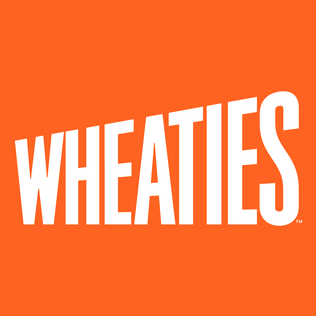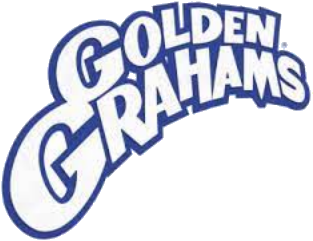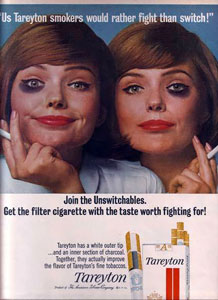
Advertising is the practice and techniques employed to bring attention to a product or service. Advertising aims to put a product or service in the spotlight in hopes of drawing it attention from consumers. It is typically used to promote a specific good or service, but there are wide range of uses, the most common being the commercial advertisement.

Lucky Charms is a brand of breakfast cereal produced by General Mills since 1964. The cereal consists of multi-colored marshmallows and pieces of shaped pulverized oat, each resembling one of several objects or symbols associated with good luck. The packaging and marketing features a leprechaun mascot, Lucky.

Breakfast cereal is a breakfast food made from processed cereal grains. It is traditionally eaten as part of breakfast, or a snack food, primarily in Western societies.

General Mills, Inc., is an American multinational manufacturer and marketer of branded processed consumer foods sold through retail stores. Founded on the banks of the Mississippi River at Saint Anthony Falls in Minneapolis, the company originally gained fame for being a large flour miller. Today, the company markets many well-known North American brands, including Gold Medal flour, Annie's Homegrown, Lärabar, Cascadian Farm, Betty Crocker, Yoplait, Nature Valley, Totino's, Pillsbury, Old El Paso, Häagen-Dazs, as well as breakfast cereals under the General Mills name, including Cheerios, Wheaties, Chex, Lucky Charms, Trix, Cocoa Puffs and Count Chocula and the other monster cereals.

A television advertisement is a span of television programming produced and paid for by an organization. It conveys a message promoting, and aiming to market, a product, service or idea. Advertisers and marketers may refer to television commercials as TVCs.

Corn Pops is a puffed grain breakfast cereal made by WK Kellogg Co, described by the company as "crunchy sweetened popped-up corn cereal." The cereal was introduced in 1950 as "Corn Pops". In 1951, the name was changed to "Sugar Corn Pops" and later to "Sugar Pops". It was the sponsor for The Adventures of Wild Bill Hickok radio and television show. The name was changed back to 'Sugar Corn Pops' in 1978, and finally returned to 'Corn Pops' in 1984, a time when many cereals dropped the word "sugar" from their titles for marketing reasons. In January 2006, the name of the cereal was changed to 'Pops', but after a few months of poor reception was changed back to Corn Pops.

Wheaties is an American brand of breakfast cereal that is made by General Mills. It is well known for featuring prominent athletes on its packages and has become a cultural icon in the United States. Originally introduced as Washburn's Gold Medal Whole Wheat Flakes in 1924, it is primarily a wheat and bran mixture baked into flakes.

Golden Crisp, also known as Sugar Crisp in Canada, is a brand of breakfast cereal made by Post Consumer Brands that consists of sweetened, candy-coated puffed wheat and is noted for its high sugar content. It was introduced in the United States in 1948.
Jim Long was an American entrepreneur, whose pioneering marketing concepts and creative “firsts” are iconic in the broadcast music industry.

Chex is an American brand of breakfast cereal currently manufactured by General Mills. It was originally known as Shredded Ralston, first produced in 1936 and owned by Ralston Purina of St. Louis, Missouri, then later renamed Chex in 1950. The Chex brand went with corporate spinoff Ralcorp in 1994 and was then sold to General Mills in 1997. Rival cereal company Kellogg's has the rights to the Chex brand in South Korea and Singapore.

Uncle Tobys is an Australian food manufacturing company which specialises in breakfast oat products. Since its foundation in 1861, the company has expanded its product range across the cereal and ready-to-eat snack market. Uncle Tobys is currently operated as a wholly owned subsidiary of Nestlé, after being acquired in 2006. Uncle Tobys’ main factory is situated in the town of Wahgunyah, Victoria.

Force was the first commercially successful wheat flake breakfast cereal. Prior to this, the only successful wheat-based cereal products had been Shredded Wheat and the hot semolina cereal, Cream of Wheat. The product was cheap to produce and kept well on store shelves. First produced in 1901 by the Force Food Company in Buffalo, New York, it was one of three companies owned by Edward Ellsworth and advertised using a popular cartoon figure called Sunny Jim.

Golden Grahams is a brand of breakfast cereal owned by Cereal Partners. It is produced under the Nestlé brand worldwide, except in the US and Canada, where it is sold under the General Mills brand.
Music in advertising refers to music integrated into mass electronic media advertisements to enhance its success. Music in advertising affects the way viewers perceive the brand by different means and on different levels, and "can significantly affect the emotional response to television commercials." It also affects the musicians whose music is featured in advertisements.
In the United States, commercial radio stations make most of their revenue by selling airtime to be used for running radio advertisements. These advertisements are the result of a business or a service providing a valuable consideration, usually money, in exchange for the station airing their commercial or mentioning them on air. The most common advertisements are "spot commercials", which normally last for no more than one minute, and longer programs, commonly running up to one hour, known as "informercials".

Jack Armstrong, the All-American Boy was a radio adventure series which maintained its popularity from 1933 to 1951. The program originated at WBBM in Chicago on July 31, 1933, and was later carried on CBS, then NBC and finally ABC.

Honey Monster Puffs is a breakfast cereal manufactured in the United Kingdom from puffed wheat sweetened with sugar and honey, fortified with vitamins and iron. The cereal was originally sold as Sugar Puffs, but was re-branded in 2014. It was labelled as Honey Monster Sugar Puffs for a time. The cereal is known for its Honey Monster mascot, a large, hairy, yellow creature introduced in 1976.
Aeroplane Jelly is a jelly brand in Australia created in 1927 by Bert Appleroth. Appleroth's backyard business, Traders Pty Ltd, became one of Australia's largest family-operated food manufacturers and was sold to McCormick Foods Australia, a subsidiary of United States corporation McCormick & Company, in 1995. Aeroplane Jelly is the market leader in Australia's jelly market, with over 18 million packets sold annually. Strawberry is the best-selling flavour.

"Us Tareyton smokers would rather fight than switch!" is a slogan that appeared in magazine, newspaper, and television advertisements for Tareyton cigarettes from 1963 until 1981. It was the American Tobacco Company's most visible advertising campaign in the 1960s and 1970s.

Nesquik is a brand of food products made by Swiss company Nestlé. In 1948, Nestlé launched a drink mix for chocolate-flavored milk called Nestlé Quik in the United States; this was released in Europe during the 1950s as Nesquik.















